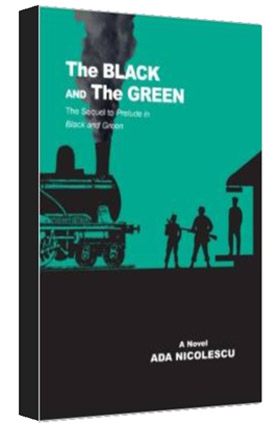Set in Romania in the years prior to and during WWII, The Black and The Green relates the Jewish experience in a way that has never been told before. By recounting events through the eyes of the Stein family, the novel takes the reader on an emotionally galvanizing roller coaster through a chapter in history that was as unique as it was complex. Unlike other countries, the Final Solution in Romania was executed not by the SS, but by the Romanian Fascist government which was an ally of Germany, not an occupied land. Increasingly over time, the comfortable world the Jewish community had known was subjected to seemingly random acts of violence from both the fanatical anti-Semitic campaign by the Iron Guard (the Fascist organization whose members wore green shirts and black pants) and the erratic policies of the Romanian dictator Ion Antonescu (the Mareshal). Despite discrimination and danger encroaching from virtually every side, the Jewish resistance effort exhibited extraordinary resilience and courage, notable for individual acts of heroism and the indomitable will to survive.
Although the Stein family of The Black and The Green is fictitious, the events surrounding the Final Solution are not—nor are the many heretofore little known, shocking details about those events that were witnessed by the book’s author, and others who experienced them first hand.
“
An extremely well written book. I felt I was living in Romania during this very difficult time for Romanian Jews. Returning to continue my reading was always rewarding. The facts have all been so carefully checked that the book reads like non-fiction. There were many new revelations in this book, things I did not know. For example, I never realized King Michael was living in Romania during the whole Nazi occupation. Nor did I know about the effort to get Jewish children to safety in Palestine even when the British would not allow it. Thoroughly enjoyable trip into history. Kudos for Ada Nicolescu.”
—Alexander J. Lazar, MD
“This book is an absorbing and sobering people’s history, a unique insight into the times and personal struggles of Romanians caught in the web of Hitler and Stalin. Well-drawn characters and actual, yet often obscure events offer insight and far reaching implications that will haunt the reader.”
—Gay Partington Terry
“This is an extraordinary book. For this review there are a few elements I want to emphasize. (1) It gives a matter-of-fact account of extreme events in Romania during World War II, and because it is so real—by the choice of details, by the skill of the narrative—the book placed me right in the situation, and I felt myself living the events as they unfolded. (I think that’s why other readers with whom I’ve discussed this book have had to pause sometimes just to absorb what they’re encountering in it.) And in imagining myself facing the choices that the characters faced, I felt at a gut level something that had partly been mere abstraction for me before: a sense of the breathtaking resilience of the Jews in the face of grimmest reality (2) I grew up in a community of Holocaust survivors (Rego Park, the community depicted in the graphic novel Maus). Reading this book has made the experience of the people I grew up with so much more comprehensible. (3) One of the many gems in the book is its account of what a pogrom was really like—something I’ve sought Ito understand since my own family’s psychology was shaped by the terror of pogroms (4) Ms. Nicolescu brings to bear the deep understanding she has developed in a career as a psychiatrist, thereby creating a deep mix of history and psychological understanding. This is a book of quietly stated drama—the real deal, not melodrama—and the matter-of-fact nature of the narrative leaves the reader to experience it almost unmediated— the power of the events sneaks up on you. There are so many edge-of-the-seat dramatic situations, extraordinary turns of fortune, cliffhangers, that I could easily imagine it as a TV miniseries whose viewers would be left understanding Jewish history, the Holocaust, and the conditions of war itself in a new way—for that is how the book affected me.”
—Alan Salant
“Electrifying is the Stein family’s courageous struggle for survival in Romania during World War II in this sequel to Prelude in Black and Green. The author relates, again with fearsome authenticity, the heroic efforts of the Jewish community to counter, too often with devastating consequences, the terrors arising from their government’s alliance with Nazi Germany. Readers will be struck by the nobility of spirit that endures even in times of such danger and hopelessness.”
—Sally Ann Bailey
“No one should ever forget what happened, but first they need to know.”
—Ada Nicolescu

Leave a Reply